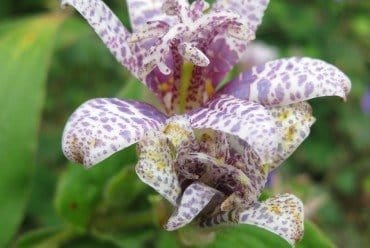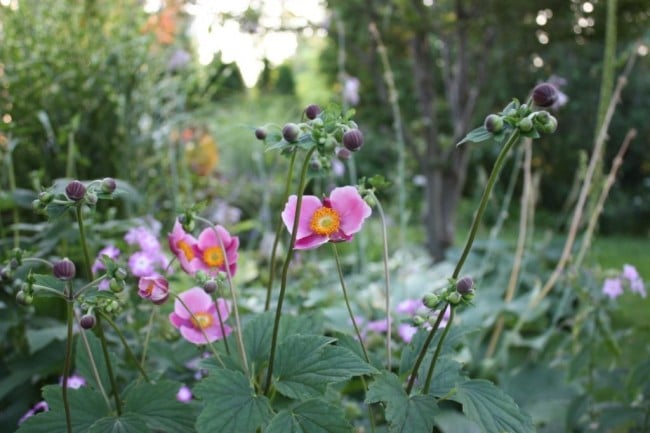I’ve just returned from a long weekend in Algonquin Park (Zone 4), where the milkweed pods are crisply split open and the tree leaves are already more than half down. The vivid autumn foliage colours peaked early, about September 26, and one morning there was thick hoar frost coating plants and lawns. These are early signs of what I can soon expect in my Zone 6 garden, and weather outlooks are predicting a cooler than usual November. So it’s time to get going in the garden!
Lowering autumn soil temperature initiates the gradual process of dormancy. Over a period of approximately six weeks, plants cease the production of carbohydrate energy and drop their leaves. Herbaceous perennials die back to their crowns, and woody plants withdraw moisture from cells and harden their tissues to withstand winter cold. As plants progress deeper into dormancy, they’re less sensitive to movement and this presents opportunities for gardeners. October and November are ideal times to move woody shrubs and roses, without causing root trauma or any check in growth.
If you have the urge to start moving shrubs around (and what gardener doesn’t?), wait for crisply cool days and night temperatures between 5° and 10°C (40° to 50°F). (It’s also possible to move shrubs in cooler weather, so long as the ground isn’t frozen.) First dig the new hole and amend the soil with organic material such as peat moss and leaves; and then use a spade to carefully thrust down around the root ball and lever the shrub out of the ground, retaining as much soil as possible around the roots. Transport it in a wheelbarrow (or drag it along the ground in a child’s plastic snow sled) to the new hole. Determine which side is the front of the shrub and settle it in at the same level as it was previously, backfill half the soil and then provide a generous amount of water into the hole. When the water has drained, finish backfilling the soil, water again, and put a three-inch (8-cm) thick mulch of leaves around the shrub. Wait until spring to provide a feeding of liquid transplant solution. If you’re transplanting roses, set the bud union three to four inches (8 to 10 cm) below ground level and hill them up with eight inches (20 cm) of leaves, compost or potting soil. Step back and enjoy the satisfaction of a successful move!
Other related articles on Garden Making:
Hole depth affects tree health
Growing better with plant stimulants
Bulb foliage, hiding in plain view
Keep planting bulbs! But think about partnering them with perennials that will hide the bulb foliage as it ripens. Daylilies make an early growth start and their long blades are good cover for narcissus and daffodil leaves. Tulip leaves can stand next to expanding peony foliage and hardly be noticed. The large leaves of rhubarb will camouflage the long strappy foliage of huge ornamental onions, such as Allium giganteum ‘Globemaster’. Siberian irises are clever partners with the grass-like leaves of their earlier and shorter cousins, Iris reticulata and I. danfordiae. Crocus and chives are also suitable partners, sharing similar leaf forms. Bulb foliage requires about six weeks to make energy for next year’s flowers, and hiding ripening bulb leaves next to perennial partners will keep you from being tempted to cut back the leaves before their work is done.
Still blooming: toad lilies & Japanese anemones

The Japanese toad lilies (Tricyrtis hirta, Zone 5) are out and looking like orchids among shady rocks at my front door. Their arching stems and symmetrical ladder-like leaves are an architectural statement worth showing off all season.
My most trusted perennial plant authority, Allan M. Armitage, says, “That the flowers tend to be spotted and brownish maroon like a toad is simple bad luck, because no matter how shamelessly one promotes the plant and flower, it is not until you see it in its glory that it can be appreciated.”
Well, he’s right. I think the one I have is Formosa toad lily (Tricyrtis formosana var. stolonifera, Zone 4), with purple and mauve shades and dots on a white background. These are such late bloomers that last year the flowers froze before opening. But this summer’s heat has really brought them along early, and I’m enjoying their small and exotic charms.

Just across the path are some clumps of Japanese anemones, their sprays of bright flowers suspended atop thin and springy stems, another enthusiastic autumn flowering plant that never fails to open in chilly air.
I’ve finally got the staggered heights just right: semi-double Anemone x hybrida ‘Honorine Jobert’ is blazing white on five-foot (1.5-m) stems and towers over 40-inch (1-m) raspberry-pink A. hupehensis ‘September Charm’. I dug out the insipid blush-pink A. tomentosa ‘Robustissima’ (a big name for a mostly unsatisfying plant), which had the bad manners to run roots all over the place. Getting these anemones in position (taller in back, shorter in front) is like trying to arrange a choir with a lot of gangly-legged kids. They keep mixing it up and making a ruckus.
Timely garlic
October is the most perfect month to plant garlic, so do it. Read Gayla Trail’s article on garlic growing in the fall issue of Garden Making, and then find some fat cloves (even if they must be from the supermarket) and thrust them into soil. You’ll never regret it. Garlic is an amusing plant that makes you smile—watching it grow is better than television!
Hope to see you again, here at Garden Making.

To Dugald Cameron, Oct. 18
Hi Dugald,
If those chrysanthemums are from your plant list at http://www.gardenimport.com, it must be a spectacular bouquet!
You'll see my seed order soon.
re: Bulb Foliage
Another perfect pairing for Daffodils (Narcissus) are Daylilies (Hemerocallis) because they have similar foliage and grow at the right time.
re: Fall flowering perennials
Hardy Chrysanthemums are great for fall flower. I have a lovely bouquet from my garden on our Thanksgiving table.
Dugald Cameron
To Suzin, Oct. 14
Hello Suzin,
Yes, Algonquin Park is a jewel! I try to go twice a year — August and October — and the transformation from late summer (lush green) to early autumn (vivid colours) is always dramatic.
The most reliable source for unsulphured molasses is a health food store. Occasionally it can be found in supermarkets, but that's often inconsistent. Hope your plants like it!
We were at our cottage the first week of October, on the first rainy day we headed to Algonquin Park and we were treated to a fantastic color show made all the more vibrant with the rain! It is such a special place. We are so fortunate to have it and protected for all future generations. Judith where did you purchase "unsulfured molasses" for your plant tonic? I'm having a hard time finding it.
Re: Petunia 'Almost Picasso'
Vigorous grower, looks good but smells awful. Had to throw it out because you could smell it from about 40 fet away. Were wondering what the smell was at first, until we tracked it down to Picasso. Smell was worse on humid days or after it rained.
Not trying that again.
Monika Kreitzler